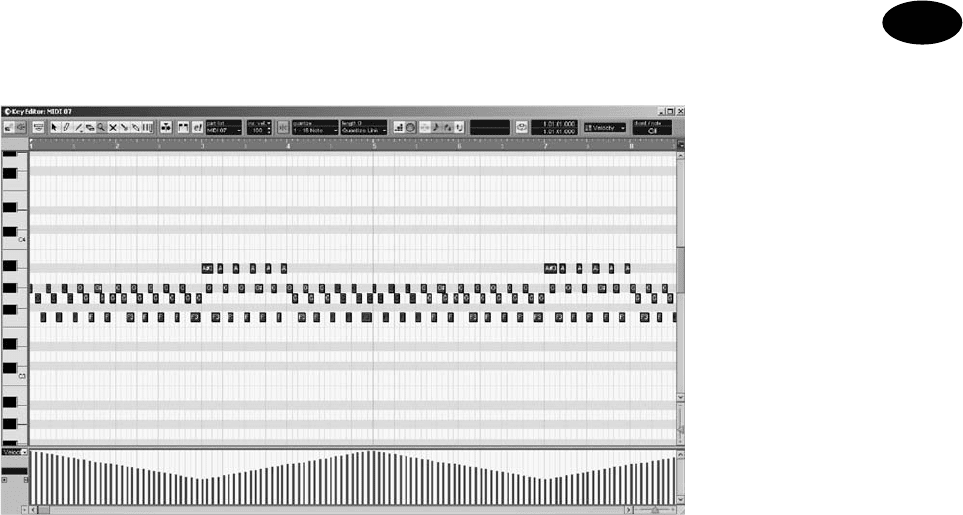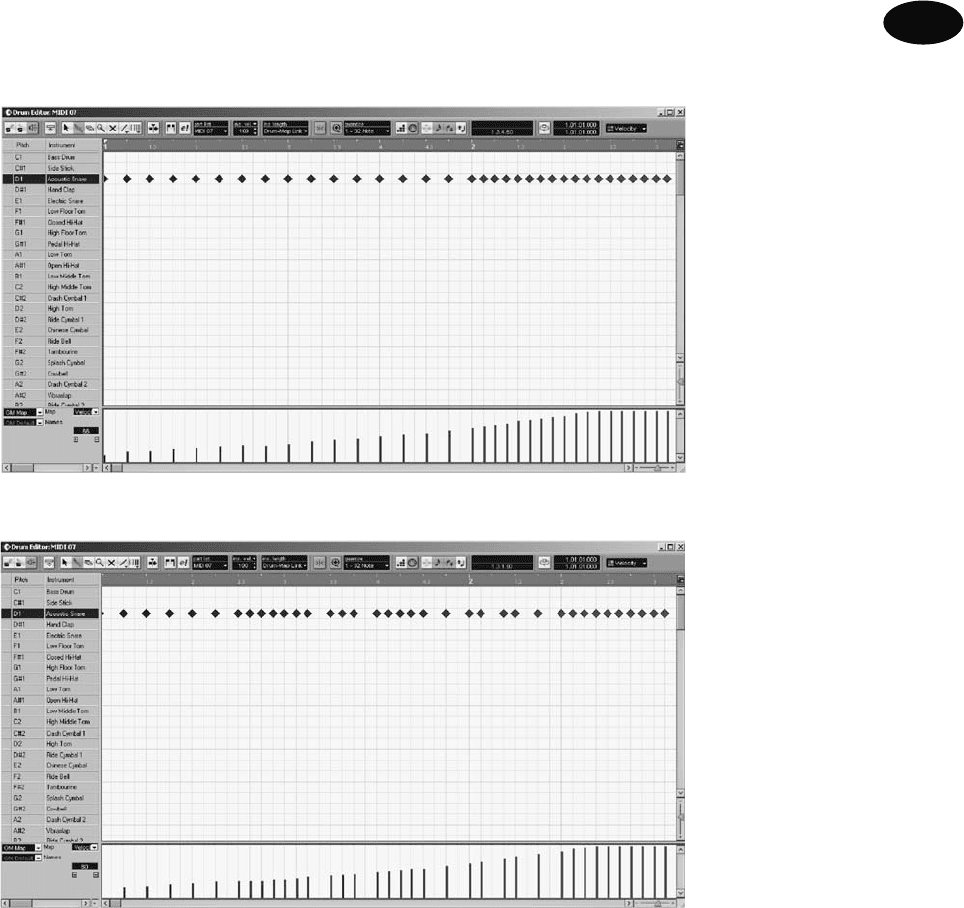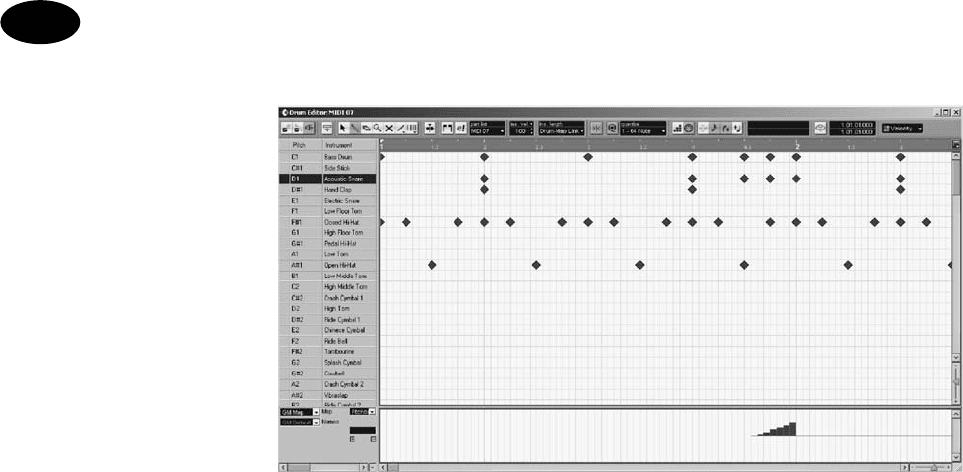Snoman R. Dance Music Manual: Tools, Toys, and Techniques
Подождите немного. Документ загружается.


PART 2
Dance Genres
264
■ Small sustain
■ Short release
■ Filter
■ Low-pass 24 dB
■ Modulation
■ Sine wave LFO positively modulates pulse width of oscillator 1
■ Triangle wave LFO positively modulates pulse width of oscillator 2
■ Filter keyfollow to maximum
■ Filter cut-off modulated with velocity commands
This is naturally open to artistic licence, and once the basics of the lead are
down, it’s prudent to experiment by replacing oscillators, the LFO waveforms,
depths and envelope settings to create variations. If this technique does not
produce a lead that is rich enough, then it’s worth employing a number of
methods to make it ‘bigger’, such as layering, doubling, splitting, hocketing or
residual synthesis as discussed in the chapter on sound design.
Finally, the timbre will also benefi t heavily from applying both reverb and
delay. The reverb is often applied quite heavily as a send effect but with 50 ms
of pre-delay so that the transient pulls through undisturbed and the tail set
quite short to prevent it from washing over the successive notes.
For the delay, this is best used as a send effect but the settings will depend on
the type of sound you require. Generally speaking, the delays should be set to
less than 30 ms to produce the granular delay effect to make the timbre appear
big in the mix, but, as always, experimentation with longer settings may pro-
duce the results you prefer.
If vocals are employed in the track then there may be little need for any effects as
the lead should sit under them. However, if you want to keep a wide harmonically
rich sound and vocals, it’s wise to employ a compressor on the lead timbre and
feed the vocals into a side chain so that the lead drops when the vocals are present.
MOTIFS AND CHORD PROGRESSIONS
With both main melody and the all essential groove down, the fi nal stage is to
add motifs and any chord progressions. The latter progressions should require
little explanation as, if used, it’s simply a case of producing a chord structure
that harmonizes with the lead and the bass. Motifs, on the other hand, are a
little more complex and require more thought. These counter melodies are the
small ad-lib riffs best referred to as the icing used to fi nally decorate the musi-
cal cake and play an essential part of any dance music, adding much needed
variation to what otherwise would be a rather repetitive track. These are often
derived from the main melodic riff as not only do they often play a role in the
beginning part of the track before the main melodic lead is introduced but they
are also re-introduced after the reprise.
There are various techniques employed to create motifs, but one of the quickest
ways is to make a copy of the MIDI lead and ‘simplify’ it by removing notes to

Trance
CHAPTER 12
265
create a much simpler pattern. Once created, this pattern can be offset from the
main lead to make the motif more noticeable, or alternatively, it can occur at the
same time as the lead but the attack and release of the timbre are lengthened. In
fact, this latter approach will often produce the best results since, as discussed,
dance music works on contrast and so far all the instruments have had a defi -
nite attack stage. By lengthening the attack and release, the motif will take on a
whole new rhythmic character which can quickly be changed by listening back
to the arrangement so far and adjusting the amplifi er envelope’s parameters.
Above all, using any of these techniques it’s sensible to avoid getting too car-
ried away and it’s vital that they are kept simple. Many dance tracks simply
use a single pitch of notes, playing every eight, sixteenth or quarter, or are con-
structed to interweave with the bass rather than the lead. This is because not
only do simple motifs have a much more dramatic effect on the music than
complex arpeggios, but you don’t want to detract too much from the main
melodic element ( Figure 12.5 ).
It should also go without saying that the timbre used for any motif should be
different from the lead melody, and it’s at this point that you’ll need to con-
sider the frequencies that are used in the mix thus far.
As touched upon, in many trance tracks the lead is harmonically rich, which
reduces the available frequencies for a motif, so it’s quite common to utilize a
low-pass fi lter cut-off to reduce the harmonic content while the lead is playing,
yet set this fi lter to open wider while there is no lead playing. Additionally, as
with all dance music, this fi lter is tweaked ‘live ’ to create additional movement
and interest throughout the arrangement. This movement obviously has to
be restrictive while the lead is playing, otherwise the mix can quickly become
FIGURE 12.5
The motif

PART 2
Dance Genres
266
swamped in frequencies and diffi cult to mix properly, but during the beginning
of the song, the fi lter can be opened wider to allow more frequencies through
to fi ll up any gaps in the mix.
More importantly, the rhythmical pitch of the motif will have to be carefully
chosen. A motif that is mostly written using notes above C4 will naturally con-
tain higher frequencies and few lower ones, so using a low-pass fi lter that is
almost closed will reduce the frequencies to nothing. Therefore, the pitch of
this motif and the timbre must occupy the low to mid-range to fi t with the bass
and the lead melody, assuming of course, that the lead melody contains higher
frequencies.
Indeed, with trance, it’s careful use of the fi lter that creates the fi nal results, and
often you will need to compromise carefully by cutting some of the frequen-
cies of the lead to leave room for the motif and vice versa. Having said that,
if the bass is quite simple, an often used technique is to programme a motif
that contains an equal amount of low frequencies as mid, and then use a fi lter
to cut higher frequencies to mix the motif in with the frequencies of the bass,
helping to enhance the low end groove, before proceeding to remove this low
end interaction by cutting the lower frequencies and leaving the higher ones in
as the track progresses. This creates the impression that all the sounds are inter-
weaving with one another helping to create more movement and the typical
‘ energy’ that appears in most club tracks.
One fi nal, yet vital, element of trance before we come to the arrangement is the
programming of rolls. Although these may not initially appear to be particu-
larly signifi cant, dance music relies on tension and drama, which best imple-
mented with well-programmed snare rolls. The quick snare rolls that interrupt
a groove along with the huge 4- or 8-bar snare roll that leads up to the main
reprise create a build-up of tension, followed by the ecstatic release when the
track returns so it’s vital that these are well designed. Typically, the snares are
the same as those used in the drum loop and are best programmed in step
time as this allows you to programme them precisely while also allowing you
to edit each note in terms of time, size and velocity. The most common snare
rolls used in this genre are programmed by dropping in MIDI notes every
1/16th followed by 32nd and then drawing in velocity that continually rises.
As a result the snares become progressively louder as the roll reaches its apex
(Figure 12.6 ).
Even though many trance tracks rely on this strictly programmed 16th/32nd
snare pattern these rolls form such an integral part of the emotion of the music
that it’s worth experimenting further to see what emotion it can convey. For
instance, rather than programming a strictly quantized pattern of notes, mix-
ing 16th and 32nd notes together with velocity that does not always climb
upwards can produce interesting variations ( Figure 12.7 ).
Along with the velocity, pitch bend can also help to add some extra anticipa-
tion by pitching the snares up as they reach the apex, or alternatively, a low-pass

Trance
CHAPTER 12
267
FIGURE 12.6
A typical trance snare
roll
FIGURE 12.7
A more intense snare
roll
fi lter across the snares which opens as the roll progresses can also help creating
a building sensation (as used in the example track).
Snare rolls should not just be restricted to the main reprise either, as shorter
rolls can be used to denote a new passage of music or the introduction of a
new instrument. This commonly consists of placing two snares near the end
of the bar a 1/16th apart. The timbre of these two snares is usually different to
indicate a form of signing off the previous bar and introducing a new one. This
is best accomplished by pitching the second snare a semitone up from the fi rst
while also placing the kick drum to play at the same time, in effect creating a
small kick/snare roll ( Figure 12.8 ).

PART 2
Dance Genres
268
Ultimately, these are only suggestions and you should be willing to spend as
much time on the snare rolls as every other instrument. The real key is to try
out variations at building and applying effects to the snares to create as much
tension as possible within the music.
THE ARRANGEMENT
With all the basic parts laid down you can begin to look at the arrangement.
Unlike most other genres of dance music, this doesn’t commonly rely on repeat-
ing phrases but generally follows a more musical structure. Possibly the best way to
accomplish this is to mute all the tracks bar the drums, begin playback, close your
eyes and listen. If you’ve listened to trance before (and if not it is strongly recom-
mended that you do!) you’ll instinctively know when a new instrument should
be introduced. However, if you’re still stuck for where to go, listen to other trance
tracks and physically count the bars, making note of where new instruments are
introduced and then implement this same structure in your own music. While this
may seem like stealing, it isn’t. Many trance tracks follow the very same arrange-
ment principles (and remember that arrangements cannot be copyrighted!).
Indeed, although it would seem unreasonable to say that all euro-trance tracks fol-
low a set pattern and rather that you should use your own integrity to produce
the arrangement, trance, like most forms of dance music, is an exact science and
it is important that you don’t stray too far from what is considered the standard.
Staying with this principle, it tends to follow a particular blueprint that normally
consist of a combination of bass, drums and inter-melodic lines that culminate
into the main uplifting climax. More often than not, this fi nal climax is a culmina-
tion of the fi rst part of the track mixed with the main melodic reprise. Occasionally,
this main reprise is different thematically from the beginning section but the tim-
bre used will have been present beforehand to retain some continuity throughout.
FIGURE 12.8
Using a skip in the
rhythm to introduce
new instruments

Trance
CHAPTER 12
269
With this in mind it’s generally best to fi rst plan the track using a song map.
Trance, like all dance music, deals mostly in emotional waves, consisting of
building and dropping the arrangement to generate an emotional state in the
audience. Mathematics play a part in this, created by collecting and introducing
sounds every 4, 8, 16, or 32 bars, depending on the individual elements used
within the track and the required length. This may sound overly mechanical
but it’s a natural progression that we have all come to expect from music. As an
example, try introducing a new element into an arrangement at the seventh bar
rather than the eighth and it’ll sound off beam.
Generally speaking most trance tracks will begin with just a basic drum loop
playing over the fi rst 16 bars to allow the DJ to mix the record in. At the end of
the sixteenth bar, a new instrument is often introduced which could be signi-
fi ed by a cymbal crash, or short snare roll. This instrument is often another per-
cussive element to complement the drum loop or the bass itself to generate the
groove. This is often left playing as is for the next sixteen or thirty-two bars to
allow the clubbers to become more comfortable with the groove of the record.
After these bars, the fi rst motif tends to be introduced with another crash or
snare roll and this motif continues for the next 16 or 32 bars. Notably if this is
to play for a more prolonged period of time, it’s prudent to employ fi lter move-
ments to prevent the track from becoming tedious.
After this, the fi rst drop of the record commonly appears. This often consists of
dropping the percussive elements bar the kick drum and motif and may con-
tinue for 4 or sometimes even 8 bars. At the end of the fi nal bar of this drop, a
crash or short snare roll is used again to signify the groove of the record return-
ing along with another new element. In many instances, this new element is
the lead motif which has been sliced up and simplifi ed. This is to give the audi-
ence a ‘taster’ of what is to come later in the record. How long this plays for
depends on the track itself but generally it can range from 16 to 32 bars with a
cymbal crash or small snare roll/double kick placed at the end of every fourth
bar to keep the interest. Occasionally, the lead riff may also be fi ltered with
a low-pass fi lter which is gradually opened at the fi nal 4 bars of this section,
often complemented with a 4-bar snare roll and perhaps a pad or string sec-
tion laid underneath.
A crash cymbal placed at the end of the fi nal bar, treated to reverb and delay
so that it echoes across the track, is often implemented as the rest of the mix
drops leaving just the fi ltered down lead or the previously introduced pads.
These pads/leads continue for 4 to 8bars whereby a 4- or 8-bar snare roll is
built behind the instruments creating an emotional rise towards the reprise of
the track. This breakdown and build-up forms an essential part of trance and
has to be executed carefully, as the whole idea is to link one fast section to
another without losing the speed or feel of the track.
At the end of the snare roll, the same crash that was used to signify the start of the
breakdown is commonly used to echo across the introduction of the full track
and all of the previous instruments are playing together to create a crescendo

PART 2
Dance Genres
270
of emotion. At this point, additional snares are often introduced to add a skip
to the rhythm and a few sweeping effects or an additional motif is introduced.
This often plays over 32 bars but sometimes 64 with a cymbal crash placed at
the end of every fourth bar. Finally a 2-bar snare roll often signifi es the removal
of instruments such as the lead and melody as the track is slowly broken down
again to end with 16 bars of the drum loop.
Notably, trance relies heavily on drive and, if at this stage, it seems to meander
along, it’s prudent to inject some additional drive into the patterns. Typically
this can be accomplished by changing the position of some elements in rela-
tion to the rest of the rhythm. For instance, keeping the kicks sat fi rmly on the
fi rst and third beats but moving the kicks (and snares) that occur on the sec-
ond and fourth beats forward by a tick or two (so that they occur earlier in
time) will add more drive to the piece. Alternatively, moving the bass a tick or
two forward in the arrangement can add a feeling of drive.
The data CD contains a full mix of a typical Trance with narration on how it was
constructed.
RECOMMENDED LISTENING
Ultimately, the purpose of this chapter has been to give some insight into
the production of trance and there is no one defi nitive way to produce the
genre. Indeed, the best way to learn new techniques and production ethics is
to actively listen to the current market leaders and be creative with processing,
effects and synthesis. Phaser, fl angers, chorus, delay, reverb, distortion, com-
pression and noise gates are the most common processor and effects used, so
experiment by placing these in different orders to create the ‘sound’ you want.
While the arrangement and general premise of every trance track is very simi-
lar, it’s this production that differentiates it between all the others. With this in
mind, what follows is a short list of artists that, at the time of writing, are con-
sidered the most infl uential in this area:
■ Ferry Corsten
■ Redd Square
■ Binary Finery
■ Sasha
■ DJ Sammy

UK Garage
CHAPTER 13
271
271
271
UK garage has its roots fi rmly set within the development of jungle music;
therefore, before we analyse this genre, we need to examine the roots and devel-
opment of jungle.
Jungle was a complex infusion of breakbeat, reggae, dub, hardcore and artcore,
but in the majority, it is the complex rhythms which defi ned the genre. These
can be traced back to the 1970s and the evolution of breakbeat. Kool Herc, a
hip-hop DJ, began experimenting on turntables by playing only the exposed
drum loops (breaks) and continually alternating between two records, spinning
back one while the other played and vice versa. This created a continual loop of
purely drum rhythms, allowing the breakdancers to show off their skills. DJ’s
such as Grand Wizard Theodore and Afrika Bambaata began to copy this style,
adding their own twists by playing two copies of the same record but delaying
one against the other, resulting in more complex, asynchronous rhythms.
It was early 1988 and the combined evolution of the sampler and the rave
scene really sparked the breakbeat revolution. Acid house artists began to sam-
ple the breaks in records, cutting and chopping the beats together to produce
more complex breaks that were impossible for any real drummer to play natu-
rally. As these breaks became more and more complex, a new genre evolved
known as hardcore. Shifting away from the standard 4/4 loops of typical acid
house, it featured lengthy complex breaks and harsh energetic sounds that were
just too ‘hardcore’ for the other ravers.
UK Garage
CHAPTER 13
CHAPTER 13
’ When I fi
rst started to make Speed Garage, I didn’t
term it as Speed Garage. I’d been into drum and bass
for years. The scenario was, I’m not gonna try and
make drum and bass, I’m gonna take it and put it with
house and see what happens. That’s all it is, that’s the
birth of Speed Garage … ’
Armand Van Helden

PART 2
Dance Genres
272
Although initially scorned by the media and record companies as drug-induced
rubbish that wouldn’t last more than a few months, by 1992 the entire rave
scene was being absorbed in the commercial media machines. Riding on this
‘ new wave for the kids ’, record companies no longer viewed it as rubbish but
a cash cow and proceeded to dilute the market with a continuous fl ow of
watered-down rave music. Rave became commercialized and this was taking its
toll on the nightclubs.
In response to the commercialization, in 1992 two resident DJs – Fabio and
Grooverider – pushed the hardcore sound to a new level by increasing the
speed of the records from the usual 120 to 145 BPM. The infl uences of house
and techno were dropped and quickly replaced with ragga and dancehall,
resulting in mixes with fast complex beats and a deep bass. Although jungle
didn’t exist as a genre just yet, these faster rhythms mixed with deep basses
inspired artists to push the boundaries further and up the tempo to a more
staggering 160 –180 BPM.
To some, the term ‘jungle’ was attributed to racism but the name was derived
from the 1920s. It was used on fl yers to describe music produced by Duke
Ellington. This featured exotic fast drum rhythms and when Rebel MC sampled
an old dancehall track with the lyrics ‘Alla the Junglists ’, ‘jungle’ became syn-
onymous with music that had a fast beat and a deep, throbbing bass. This was
further augmented by pioneers of the genre such as Moose and Danny Jungle.
Jungle enjoyed a good 3 –4 years of popularity, but as the beats and bass line
became darker and more minimal, and drum ‘n’ bass took over, the music lost
a majority of its appeal to the more mainstream UK audiences. Drum ‘n’ bass
and jungle were described as far too aggressive and clubbers wanted a happier
vibe to dance to.
This is where the history of garage becomes disjointed to many. Garage had
already existed before the jungle revolution but not in the US term of garage.
This was a term derived from Larry Levan’s Paradise Garage, which incorporated
a broad range of musical styles. The earlier UK garage was a laid-back form of
house music with mellow beats and vocals. Often referred to as ‘Sunday music ’
because it was music that wasn’t popular enough to be played to the main-
stream on Friday and Saturday nights, it was an evolution of jungle that bought
garage to the masses.
To many, it was Armand Van Helden’s remix of Sugar Is Sweeter by CJ Bolland
in 1996 that started the garage phenomenon. By mixing house beats with the
slow dub/warping bass lines of jungle and time-stretched vocals, the genre was
soon labelled ‘speed garage’. This was further augmented with his next release of
Spin Spin Sugar by the Sneaker Pimps . Further artists such as RIP , Dreem Teem ,
Booker and 187 Lockdown began to add their own unique styles to the music.
Todd Edwards, a producer from New Jersey, began to experiment further with the
garage sound. He started to strip down the verse and chorus and instead picked
out vocal phrases, choosing to play them like instruments and experimenting

UK Garage
CHAPTER 13
273
with the latest sampling technology of the time to make them stand out above
the crowds. One such technique was pitch-shifting individual syllables, a style
that has become characteristic of the whole UK garage scene.
By 1997, the genre of speed garage began to diversify with the evolution of 2-
step garage. This broke down the 4/4 rhythms of speed garage by removing the
second and fourth bass kick from each bar, placing an open high-hat on the
upbeat and introducing syncopated bass lines, altogether giving the rhythms a
funkier feel. MJ Cole , The Artful Dodger , Ed Cas, Shanks and Bigfoot and the
Dreem Teem are all accredited with evolving this new genre, although for many
it was Baby Can I Get Your Number by Silo that pioneered and paved the way for
2-step garage.
In 2000, 2-step garage hit the mainstream charts with releases from Craig
David and Daniel Beddingfi eld . However, it wasn’t long before the record com-
panies took their hold on this new genre and the charts were bombarded with
track after track of 2-step ‘pop’ garage for the masses. As those passionate about
the music – not the money – tried to distance themselves, breakstep garage was
born. This exhibited heavier break beats than before and deeper bass lines. This
was further evolved into dub-step, a much more minimalist approach to the
rhythms but still featuring heavy dub bass lines.
MUSICAL ANALYSIS
The most profi cient way to approach writing garage is to fi nd the most popu-
lar tracks around at the moment and break them down to their basic elements.
Once this is accomplished we can begin to examine the similarities between
each track and determine exactly what it is that differentiates it from other musi-
cal styles. In fact, all music that can be placed into a genre-specifi c category will
share similarities in terms of the arrangement, groove and sonic elements.
However, in the case of garage, the divergence of the genre over the subsequent
years has resulted in a genre that has become heavily fragmented and as such
cannot be easily identifi ed as featuring any one particular attribute. It can fea-
ture house rhythms with slow pounding bass lines, it can incorporate more
funky rhythms or it can be extremely minimalist. Indeed, since garage takes
its infl uence from just about every other form of music it is near impossible to
analyse the genre in any exact musical sense. It is only possible to make some
very rough generalizations unless we select a specifi c genre to work with.
While garage is infl uenced by most other forms of music, its strongest roots lie
within its history: jungle, hip-hop, dancehall and R ‘n’ B. Generally the music
will use a 4/4 time signature, but sometimes with the more complex 2-step a 3/4
time signature is used. In terms of tempo, this can range from 94 to 145 BPM.
For the purpose of this chapter, we’ll examine what has been termed speed
garage (more recently reinvented and renamed ‘niche’), a genre featuring heavily
warped bass lines with straight 4/4 rhythms, a motif and time-stretched vocals.
Although we will be focusing on this genre of music, if you want to produce
